Written Assignment on Common Hazards in Healthcare Center
VerifiedAdded on 2022/10/08
|12
|2574
|13
Homework Assignment
AI Summary
This assignment addresses various aspects of hazard management in a healthcare setting. It begins by outlining reporting procedures for potential hazards, such as patients with Hepatitis B, HIV, cold sores, broken ultrasonic scaler tips, and open sharps bins. The assignment then delves into dental equipment and instruments, detailing methods for checking their correct functioning and recording maintenance. Furthermore, it explores the risks associated with failing to decontaminate equipment, the long-term effects of using damaged or pre-used sterile goods, and the types of waste routinely found in a dental setting, including proper disposal methods. The assignment emphasizes the importance of correct waste disposal to prevent harm to patients, healthcare professionals, and the environment. It provides comprehensive insights into maintaining a safe and efficient healthcare environment.
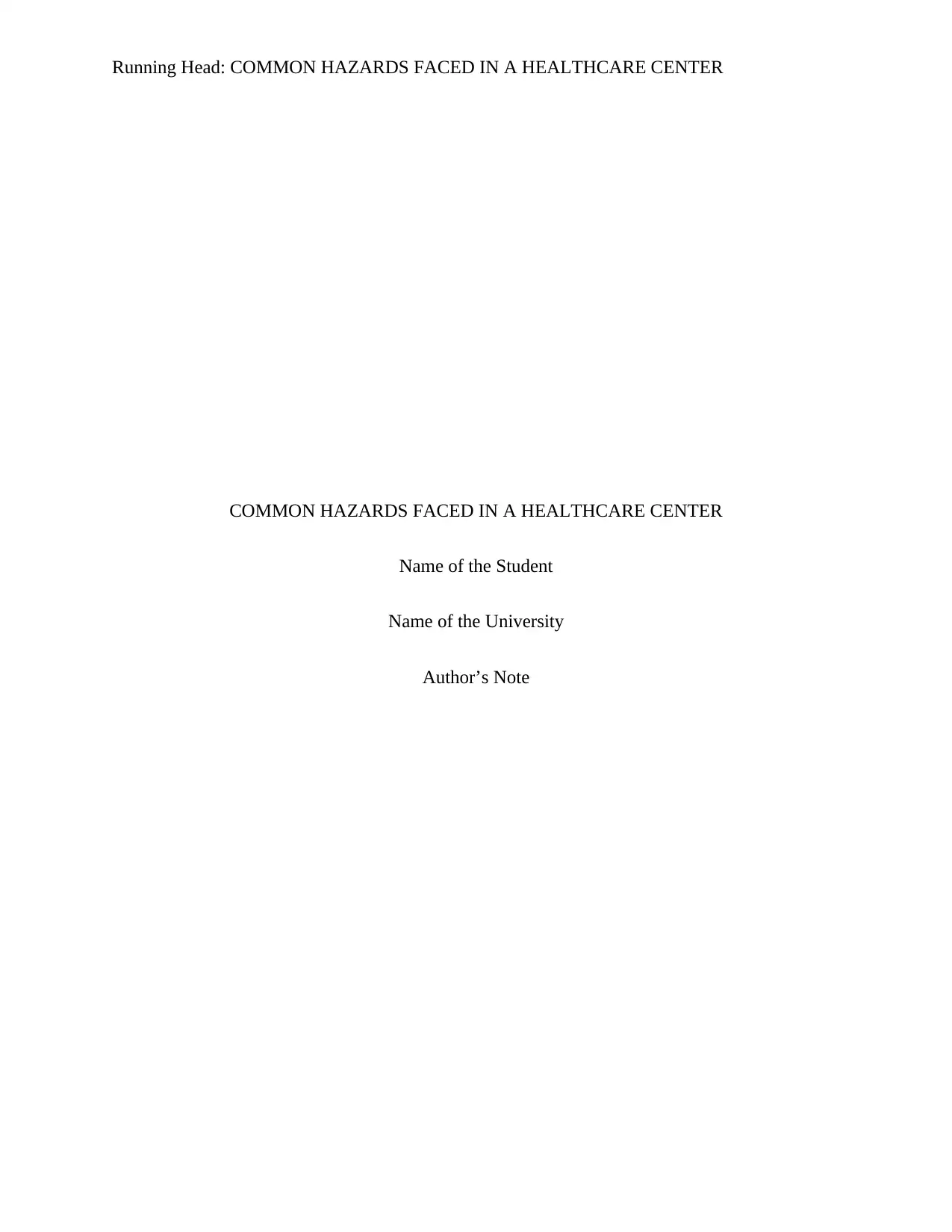
Running Head: COMMON HAZARDS FACED IN A HEALTHCARE CENTER
COMMON HAZARDS FACED IN A HEALTHCARE CENTER
Name of the Student
Name of the University
Author’s Note
COMMON HAZARDS FACED IN A HEALTHCARE CENTER
Name of the Student
Name of the University
Author’s Note
Paraphrase This Document
Need a fresh take? Get an instant paraphrase of this document with our AI Paraphraser
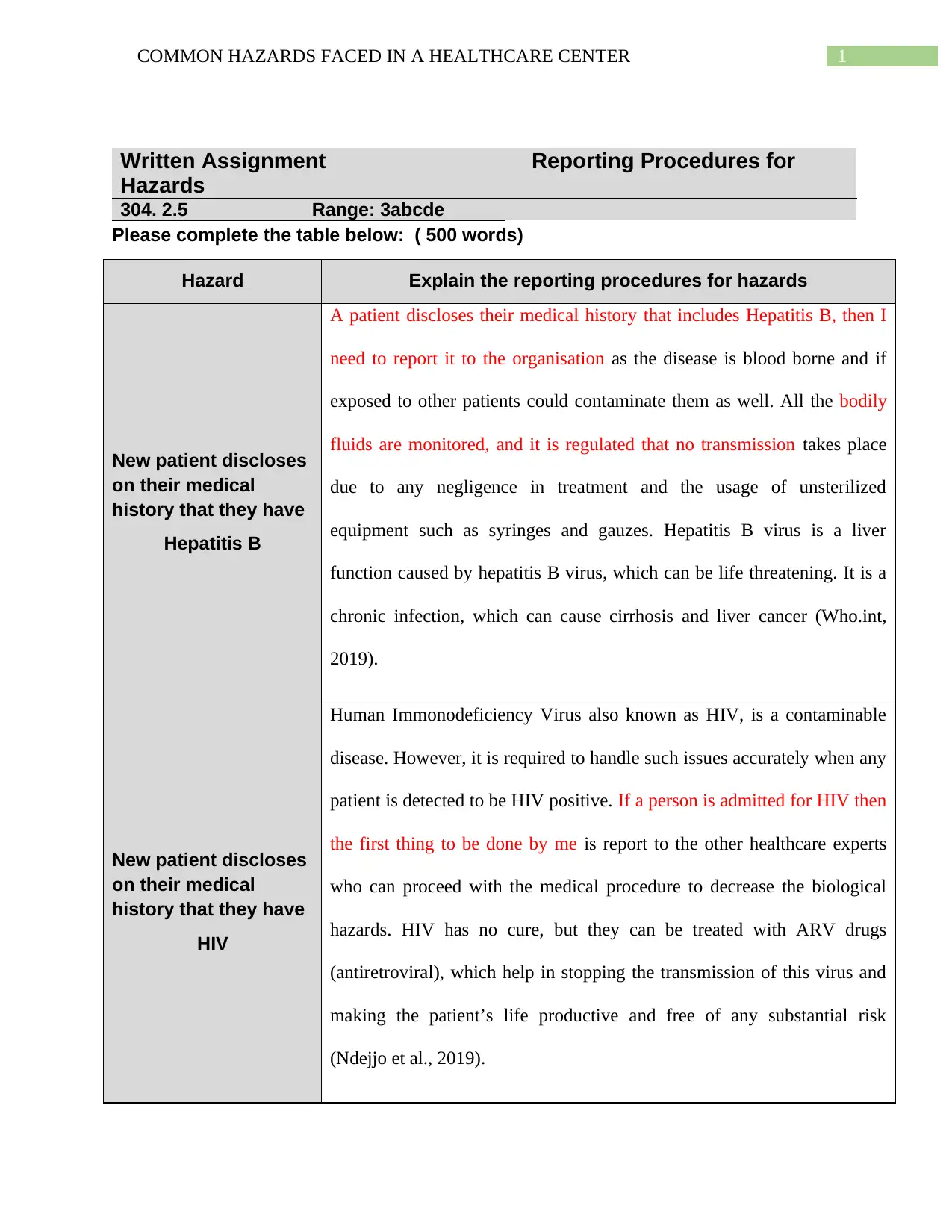
1COMMON HAZARDS FACED IN A HEALTHCARE CENTER
Written Assignment Reporting Procedures for
Hazards
304. 2.5 Range: 3abcde
Please complete the table below: ( 500 words)
Hazard Explain the reporting procedures for hazards
New patient discloses
on their medical
history that they have
Hepatitis B
A patient discloses their medical history that includes Hepatitis B, then I
need to report it to the organisation as the disease is blood borne and if
exposed to other patients could contaminate them as well. All the bodily
fluids are monitored, and it is regulated that no transmission takes place
due to any negligence in treatment and the usage of unsterilized
equipment such as syringes and gauzes. Hepatitis B virus is a liver
function caused by hepatitis B virus, which can be life threatening. It is a
chronic infection, which can cause cirrhosis and liver cancer (Who.int,
2019).
New patient discloses
on their medical
history that they have
HIV
Human Immonodeficiency Virus also known as HIV, is a contaminable
disease. However, it is required to handle such issues accurately when any
patient is detected to be HIV positive. If a person is admitted for HIV then
the first thing to be done by me is report to the other healthcare experts
who can proceed with the medical procedure to decrease the biological
hazards. HIV has no cure, but they can be treated with ARV drugs
(antiretroviral), which help in stopping the transmission of this virus and
making the patient’s life productive and free of any substantial risk
(Ndejjo et al., 2019).
Written Assignment Reporting Procedures for
Hazards
304. 2.5 Range: 3abcde
Please complete the table below: ( 500 words)
Hazard Explain the reporting procedures for hazards
New patient discloses
on their medical
history that they have
Hepatitis B
A patient discloses their medical history that includes Hepatitis B, then I
need to report it to the organisation as the disease is blood borne and if
exposed to other patients could contaminate them as well. All the bodily
fluids are monitored, and it is regulated that no transmission takes place
due to any negligence in treatment and the usage of unsterilized
equipment such as syringes and gauzes. Hepatitis B virus is a liver
function caused by hepatitis B virus, which can be life threatening. It is a
chronic infection, which can cause cirrhosis and liver cancer (Who.int,
2019).
New patient discloses
on their medical
history that they have
HIV
Human Immonodeficiency Virus also known as HIV, is a contaminable
disease. However, it is required to handle such issues accurately when any
patient is detected to be HIV positive. If a person is admitted for HIV then
the first thing to be done by me is report to the other healthcare experts
who can proceed with the medical procedure to decrease the biological
hazards. HIV has no cure, but they can be treated with ARV drugs
(antiretroviral), which help in stopping the transmission of this virus and
making the patient’s life productive and free of any substantial risk
(Ndejjo et al., 2019).
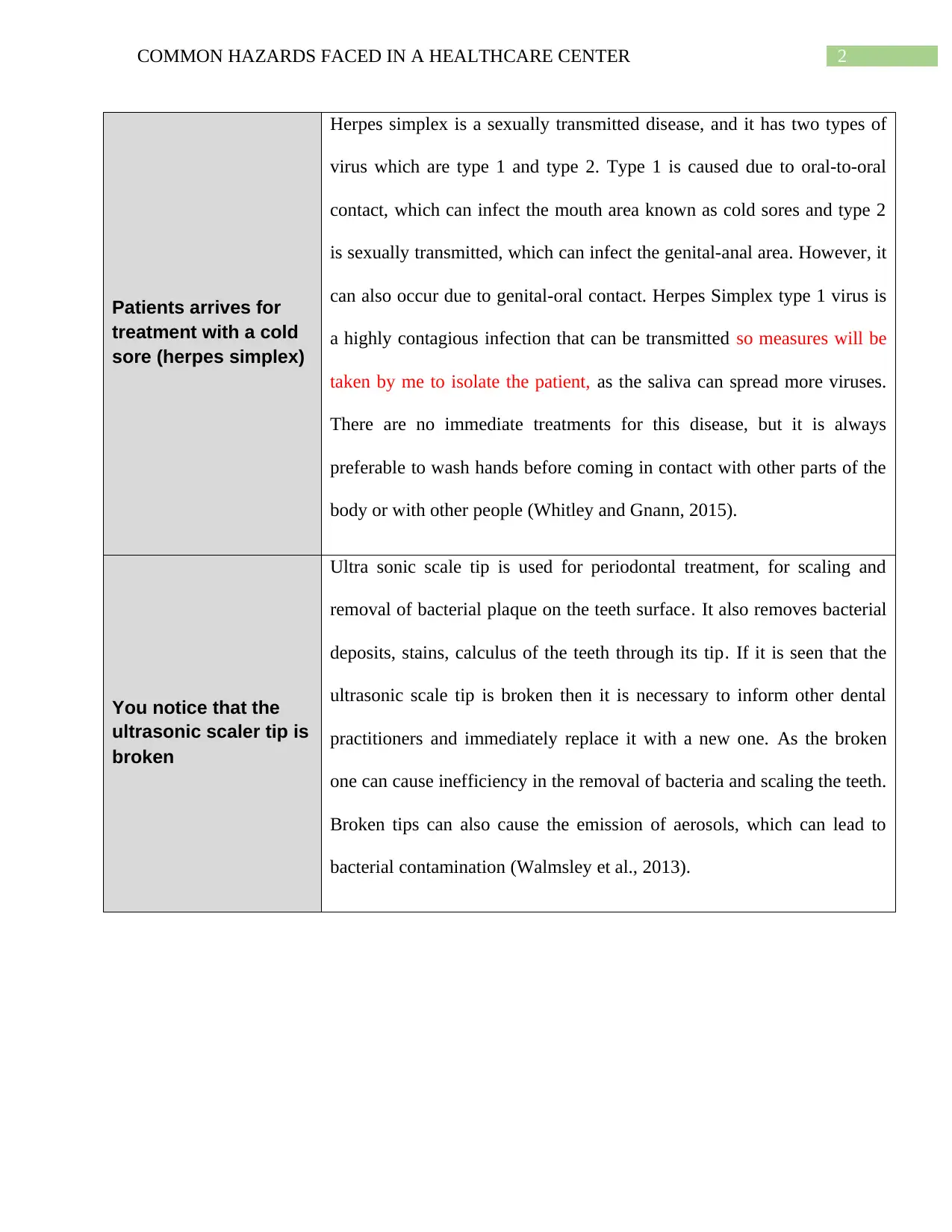
2COMMON HAZARDS FACED IN A HEALTHCARE CENTER
Patients arrives for
treatment with a cold
sore (herpes simplex)
Herpes simplex is a sexually transmitted disease, and it has two types of
virus which are type 1 and type 2. Type 1 is caused due to oral-to-oral
contact, which can infect the mouth area known as cold sores and type 2
is sexually transmitted, which can infect the genital-anal area. However, it
can also occur due to genital-oral contact. Herpes Simplex type 1 virus is
a highly contagious infection that can be transmitted so measures will be
taken by me to isolate the patient, as the saliva can spread more viruses.
There are no immediate treatments for this disease, but it is always
preferable to wash hands before coming in contact with other parts of the
body or with other people (Whitley and Gnann, 2015).
You notice that the
ultrasonic scaler tip is
broken
Ultra sonic scale tip is used for periodontal treatment, for scaling and
removal of bacterial plaque on the teeth surface. It also removes bacterial
deposits, stains, calculus of the teeth through its tip. If it is seen that the
ultrasonic scale tip is broken then it is necessary to inform other dental
practitioners and immediately replace it with a new one. As the broken
one can cause inefficiency in the removal of bacteria and scaling the teeth.
Broken tips can also cause the emission of aerosols, which can lead to
bacterial contamination (Walmsley et al., 2013).
Patients arrives for
treatment with a cold
sore (herpes simplex)
Herpes simplex is a sexually transmitted disease, and it has two types of
virus which are type 1 and type 2. Type 1 is caused due to oral-to-oral
contact, which can infect the mouth area known as cold sores and type 2
is sexually transmitted, which can infect the genital-anal area. However, it
can also occur due to genital-oral contact. Herpes Simplex type 1 virus is
a highly contagious infection that can be transmitted so measures will be
taken by me to isolate the patient, as the saliva can spread more viruses.
There are no immediate treatments for this disease, but it is always
preferable to wash hands before coming in contact with other parts of the
body or with other people (Whitley and Gnann, 2015).
You notice that the
ultrasonic scaler tip is
broken
Ultra sonic scale tip is used for periodontal treatment, for scaling and
removal of bacterial plaque on the teeth surface. It also removes bacterial
deposits, stains, calculus of the teeth through its tip. If it is seen that the
ultrasonic scale tip is broken then it is necessary to inform other dental
practitioners and immediately replace it with a new one. As the broken
one can cause inefficiency in the removal of bacteria and scaling the teeth.
Broken tips can also cause the emission of aerosols, which can lead to
bacterial contamination (Walmsley et al., 2013).
⊘ This is a preview!⊘
Do you want full access?
Subscribe today to unlock all pages.

Trusted by 1+ million students worldwide
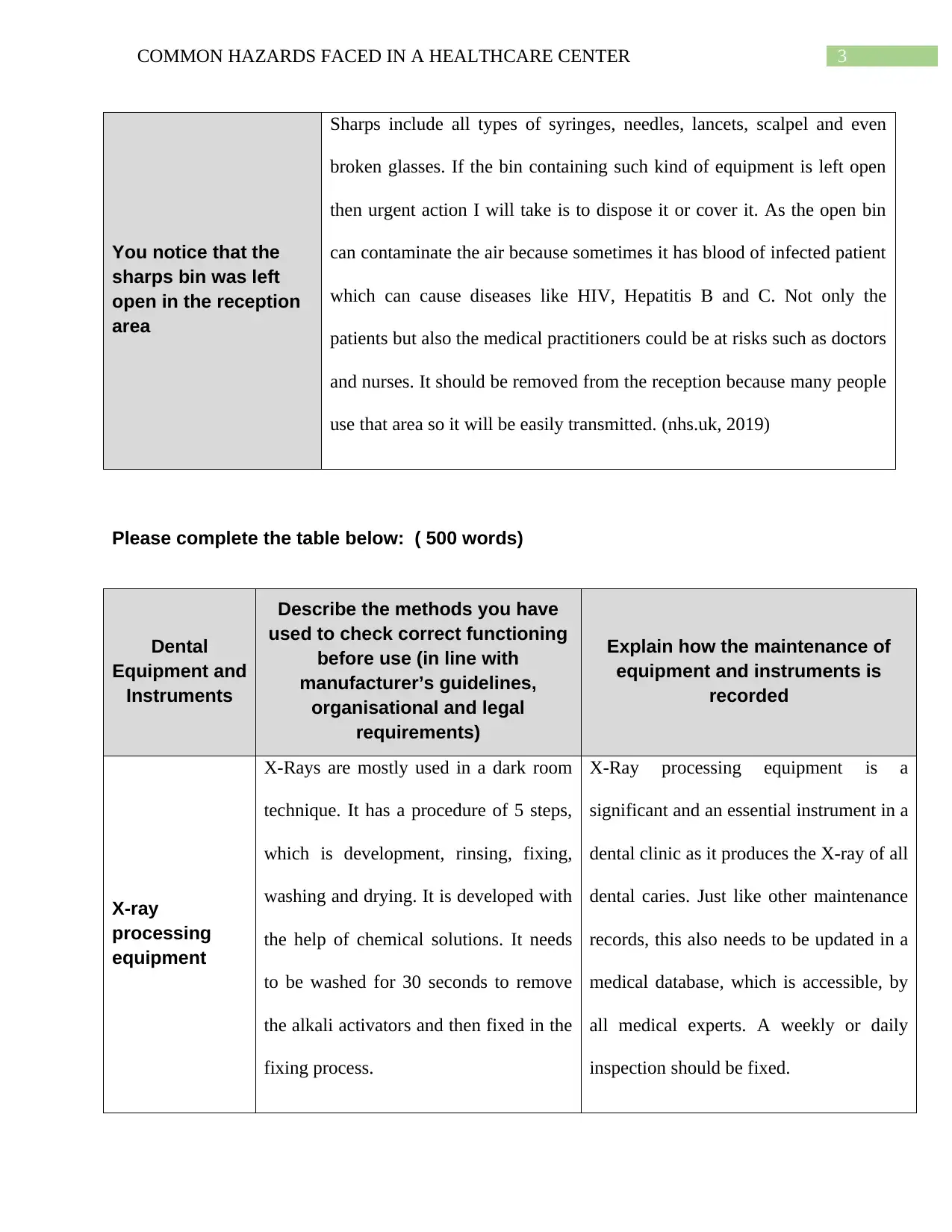
3COMMON HAZARDS FACED IN A HEALTHCARE CENTER
You notice that the
sharps bin was left
open in the reception
area
Sharps include all types of syringes, needles, lancets, scalpel and even
broken glasses. If the bin containing such kind of equipment is left open
then urgent action I will take is to dispose it or cover it. As the open bin
can contaminate the air because sometimes it has blood of infected patient
which can cause diseases like HIV, Hepatitis B and C. Not only the
patients but also the medical practitioners could be at risks such as doctors
and nurses. It should be removed from the reception because many people
use that area so it will be easily transmitted. (nhs.uk, 2019)
Please complete the table below: ( 500 words)
Dental
Equipment and
Instruments
Describe the methods you have
used to check correct functioning
before use (in line with
manufacturer’s guidelines,
organisational and legal
requirements)
Explain how the maintenance of
equipment and instruments is
recorded
X-ray
processing
equipment
X-Rays are mostly used in a dark room
technique. It has a procedure of 5 steps,
which is development, rinsing, fixing,
washing and drying. It is developed with
the help of chemical solutions. It needs
to be washed for 30 seconds to remove
the alkali activators and then fixed in the
fixing process.
X-Ray processing equipment is a
significant and an essential instrument in a
dental clinic as it produces the X-ray of all
dental caries. Just like other maintenance
records, this also needs to be updated in a
medical database, which is accessible, by
all medical experts. A weekly or daily
inspection should be fixed.
You notice that the
sharps bin was left
open in the reception
area
Sharps include all types of syringes, needles, lancets, scalpel and even
broken glasses. If the bin containing such kind of equipment is left open
then urgent action I will take is to dispose it or cover it. As the open bin
can contaminate the air because sometimes it has blood of infected patient
which can cause diseases like HIV, Hepatitis B and C. Not only the
patients but also the medical practitioners could be at risks such as doctors
and nurses. It should be removed from the reception because many people
use that area so it will be easily transmitted. (nhs.uk, 2019)
Please complete the table below: ( 500 words)
Dental
Equipment and
Instruments
Describe the methods you have
used to check correct functioning
before use (in line with
manufacturer’s guidelines,
organisational and legal
requirements)
Explain how the maintenance of
equipment and instruments is
recorded
X-ray
processing
equipment
X-Rays are mostly used in a dark room
technique. It has a procedure of 5 steps,
which is development, rinsing, fixing,
washing and drying. It is developed with
the help of chemical solutions. It needs
to be washed for 30 seconds to remove
the alkali activators and then fixed in the
fixing process.
X-Ray processing equipment is a
significant and an essential instrument in a
dental clinic as it produces the X-ray of all
dental caries. Just like other maintenance
records, this also needs to be updated in a
medical database, which is accessible, by
all medical experts. A weekly or daily
inspection should be fixed.
Paraphrase This Document
Need a fresh take? Get an instant paraphrase of this document with our AI Paraphraser
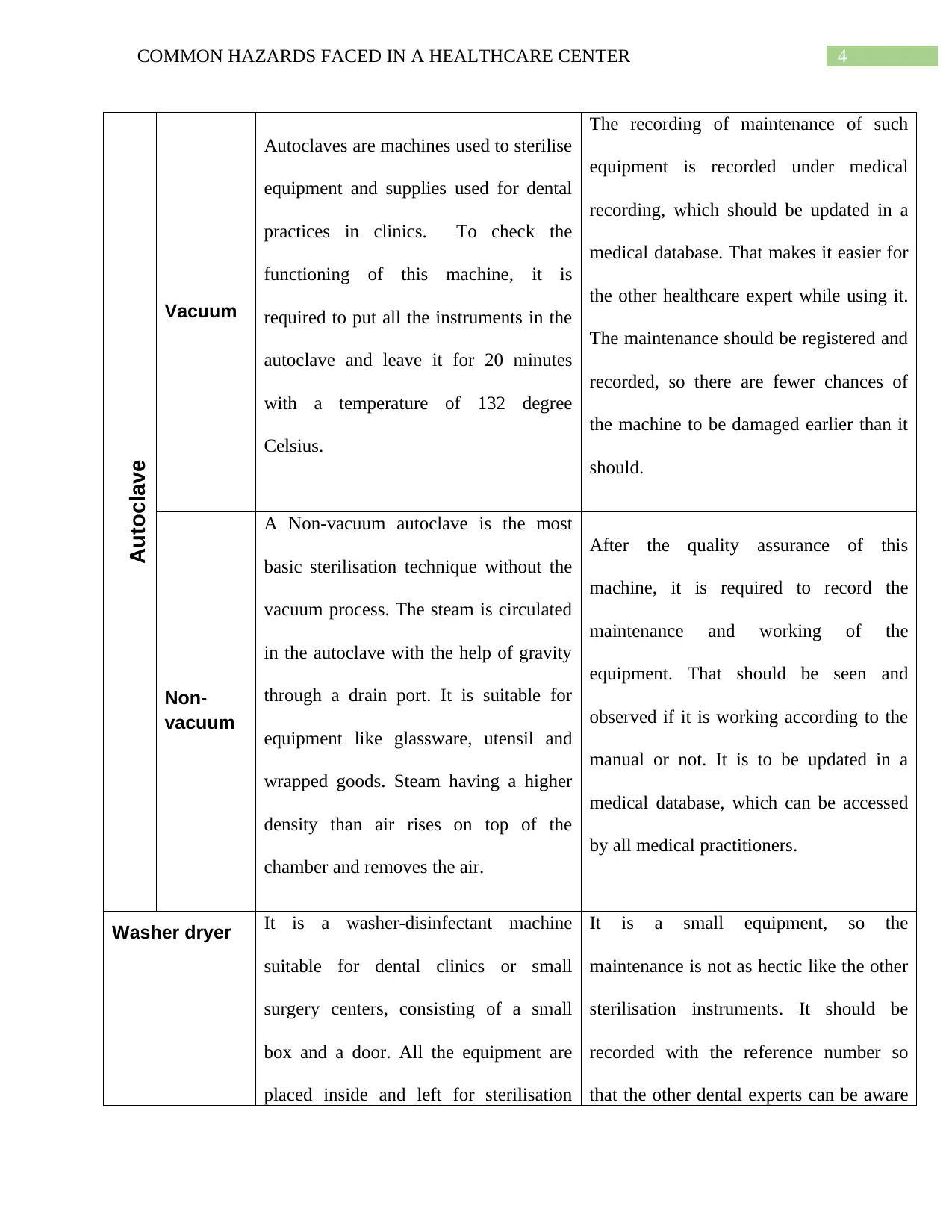
4COMMON HAZARDS FACED IN A HEALTHCARE CENTER
Autoclave
Vacuum
Autoclaves are machines used to sterilise
equipment and supplies used for dental
practices in clinics. To check the
functioning of this machine, it is
required to put all the instruments in the
autoclave and leave it for 20 minutes
with a temperature of 132 degree
Celsius.
The recording of maintenance of such
equipment is recorded under medical
recording, which should be updated in a
medical database. That makes it easier for
the other healthcare expert while using it.
The maintenance should be registered and
recorded, so there are fewer chances of
the machine to be damaged earlier than it
should.
Non-
vacuum
A Non-vacuum autoclave is the most
basic sterilisation technique without the
vacuum process. The steam is circulated
in the autoclave with the help of gravity
through a drain port. It is suitable for
equipment like glassware, utensil and
wrapped goods. Steam having a higher
density than air rises on top of the
chamber and removes the air.
After the quality assurance of this
machine, it is required to record the
maintenance and working of the
equipment. That should be seen and
observed if it is working according to the
manual or not. It is to be updated in a
medical database, which can be accessed
by all medical practitioners.
Washer dryer It is a washer-disinfectant machine
suitable for dental clinics or small
surgery centers, consisting of a small
box and a door. All the equipment are
placed inside and left for sterilisation
It is a small equipment, so the
maintenance is not as hectic like the other
sterilisation instruments. It should be
recorded with the reference number so
that the other dental experts can be aware
Autoclave
Vacuum
Autoclaves are machines used to sterilise
equipment and supplies used for dental
practices in clinics. To check the
functioning of this machine, it is
required to put all the instruments in the
autoclave and leave it for 20 minutes
with a temperature of 132 degree
Celsius.
The recording of maintenance of such
equipment is recorded under medical
recording, which should be updated in a
medical database. That makes it easier for
the other healthcare expert while using it.
The maintenance should be registered and
recorded, so there are fewer chances of
the machine to be damaged earlier than it
should.
Non-
vacuum
A Non-vacuum autoclave is the most
basic sterilisation technique without the
vacuum process. The steam is circulated
in the autoclave with the help of gravity
through a drain port. It is suitable for
equipment like glassware, utensil and
wrapped goods. Steam having a higher
density than air rises on top of the
chamber and removes the air.
After the quality assurance of this
machine, it is required to record the
maintenance and working of the
equipment. That should be seen and
observed if it is working according to the
manual or not. It is to be updated in a
medical database, which can be accessed
by all medical practitioners.
Washer dryer It is a washer-disinfectant machine
suitable for dental clinics or small
surgery centers, consisting of a small
box and a door. All the equipment are
placed inside and left for sterilisation
It is a small equipment, so the
maintenance is not as hectic like the other
sterilisation instruments. It should be
recorded with the reference number so
that the other dental experts can be aware
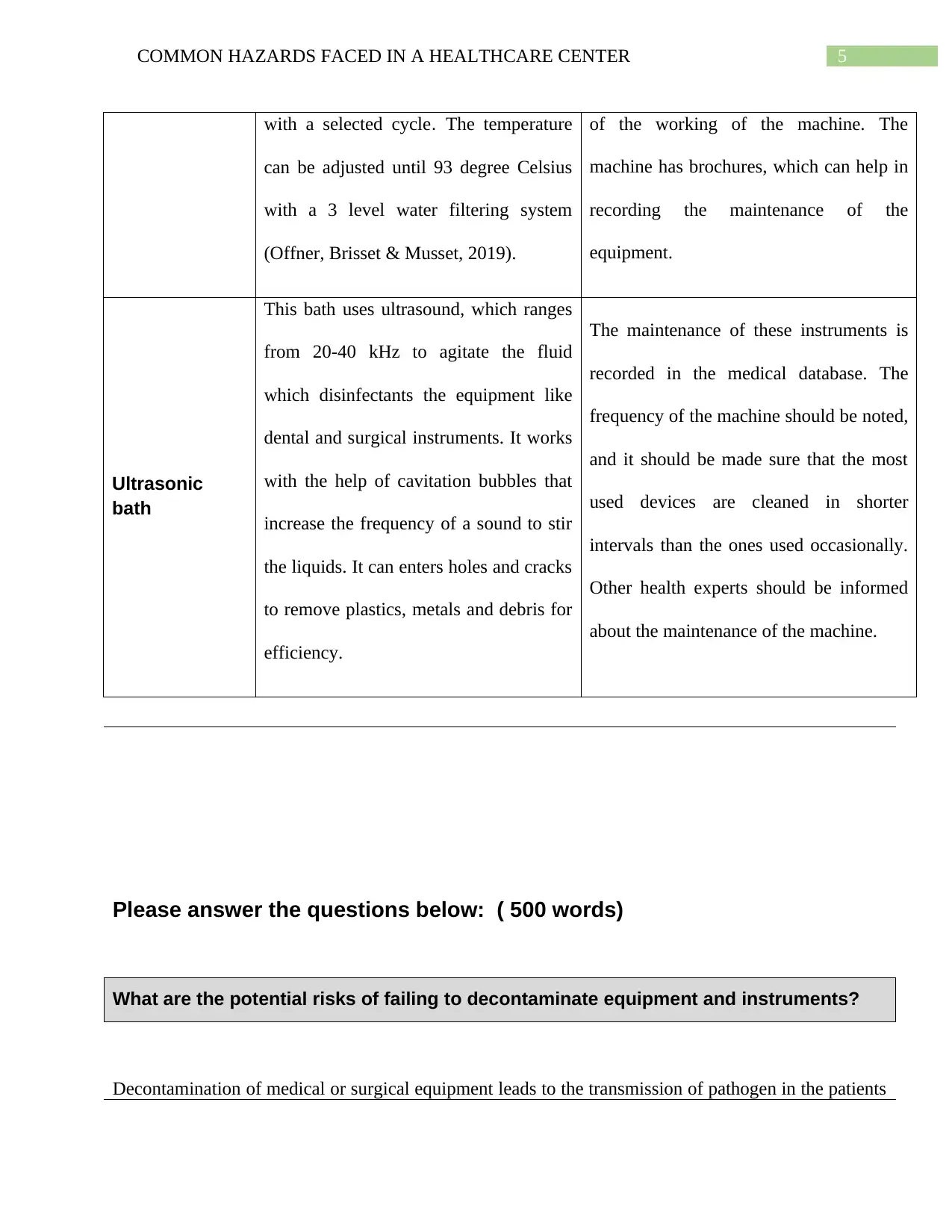
5COMMON HAZARDS FACED IN A HEALTHCARE CENTER
with a selected cycle. The temperature
can be adjusted until 93 degree Celsius
with a 3 level water filtering system
(Offner, Brisset & Musset, 2019).
of the working of the machine. The
machine has brochures, which can help in
recording the maintenance of the
equipment.
Ultrasonic
bath
This bath uses ultrasound, which ranges
from 20-40 kHz to agitate the fluid
which disinfectants the equipment like
dental and surgical instruments. It works
with the help of cavitation bubbles that
increase the frequency of a sound to stir
the liquids. It can enters holes and cracks
to remove plastics, metals and debris for
efficiency.
The maintenance of these instruments is
recorded in the medical database. The
frequency of the machine should be noted,
and it should be made sure that the most
used devices are cleaned in shorter
intervals than the ones used occasionally.
Other health experts should be informed
about the maintenance of the machine.
Please answer the questions below: ( 500 words)
What are the potential risks of failing to decontaminate equipment and instruments?
Decontamination of medical or surgical equipment leads to the transmission of pathogen in the patients
with a selected cycle. The temperature
can be adjusted until 93 degree Celsius
with a 3 level water filtering system
(Offner, Brisset & Musset, 2019).
of the working of the machine. The
machine has brochures, which can help in
recording the maintenance of the
equipment.
Ultrasonic
bath
This bath uses ultrasound, which ranges
from 20-40 kHz to agitate the fluid
which disinfectants the equipment like
dental and surgical instruments. It works
with the help of cavitation bubbles that
increase the frequency of a sound to stir
the liquids. It can enters holes and cracks
to remove plastics, metals and debris for
efficiency.
The maintenance of these instruments is
recorded in the medical database. The
frequency of the machine should be noted,
and it should be made sure that the most
used devices are cleaned in shorter
intervals than the ones used occasionally.
Other health experts should be informed
about the maintenance of the machine.
Please answer the questions below: ( 500 words)
What are the potential risks of failing to decontaminate equipment and instruments?
Decontamination of medical or surgical equipment leads to the transmission of pathogen in the patients
⊘ This is a preview!⊘
Do you want full access?
Subscribe today to unlock all pages.

Trusted by 1+ million students worldwide

6COMMON HAZARDS FACED IN A HEALTHCARE CENTER
in any healthcare. According to Southworth (2014), the most common contamination is done by
Pseudomonas aeruginosa and Mycobacterium. These pathogens can cause potential risks that can
deteriorate health conditions or cause infectious diseases. Infection of such pathogens not only causes
the transmission to host barriers but also person to person like Hepatitis B and Hepatitis C virus,
mycobacterium tuberculosis and salmonellosis. Equipment that is already used for a patient should not
be used without decontaminating for another patient as it can cause airborne to blood borne diseases
like infection during bronchoscopy, endoscopy and also HIV. It is always vital to disinfect through
procedures like autoclave, steaming or anti infecting liquids (Weber &Rutala, 2013).
What are the potential long-term effects of using damaged or pre-used sterile goods?
(e.g. using an open packet of pre-sterilised gauze or scalpel blade)
in any healthcare. According to Southworth (2014), the most common contamination is done by
Pseudomonas aeruginosa and Mycobacterium. These pathogens can cause potential risks that can
deteriorate health conditions or cause infectious diseases. Infection of such pathogens not only causes
the transmission to host barriers but also person to person like Hepatitis B and Hepatitis C virus,
mycobacterium tuberculosis and salmonellosis. Equipment that is already used for a patient should not
be used without decontaminating for another patient as it can cause airborne to blood borne diseases
like infection during bronchoscopy, endoscopy and also HIV. It is always vital to disinfect through
procedures like autoclave, steaming or anti infecting liquids (Weber &Rutala, 2013).
What are the potential long-term effects of using damaged or pre-used sterile goods?
(e.g. using an open packet of pre-sterilised gauze or scalpel blade)
Paraphrase This Document
Need a fresh take? Get an instant paraphrase of this document with our AI Paraphraser
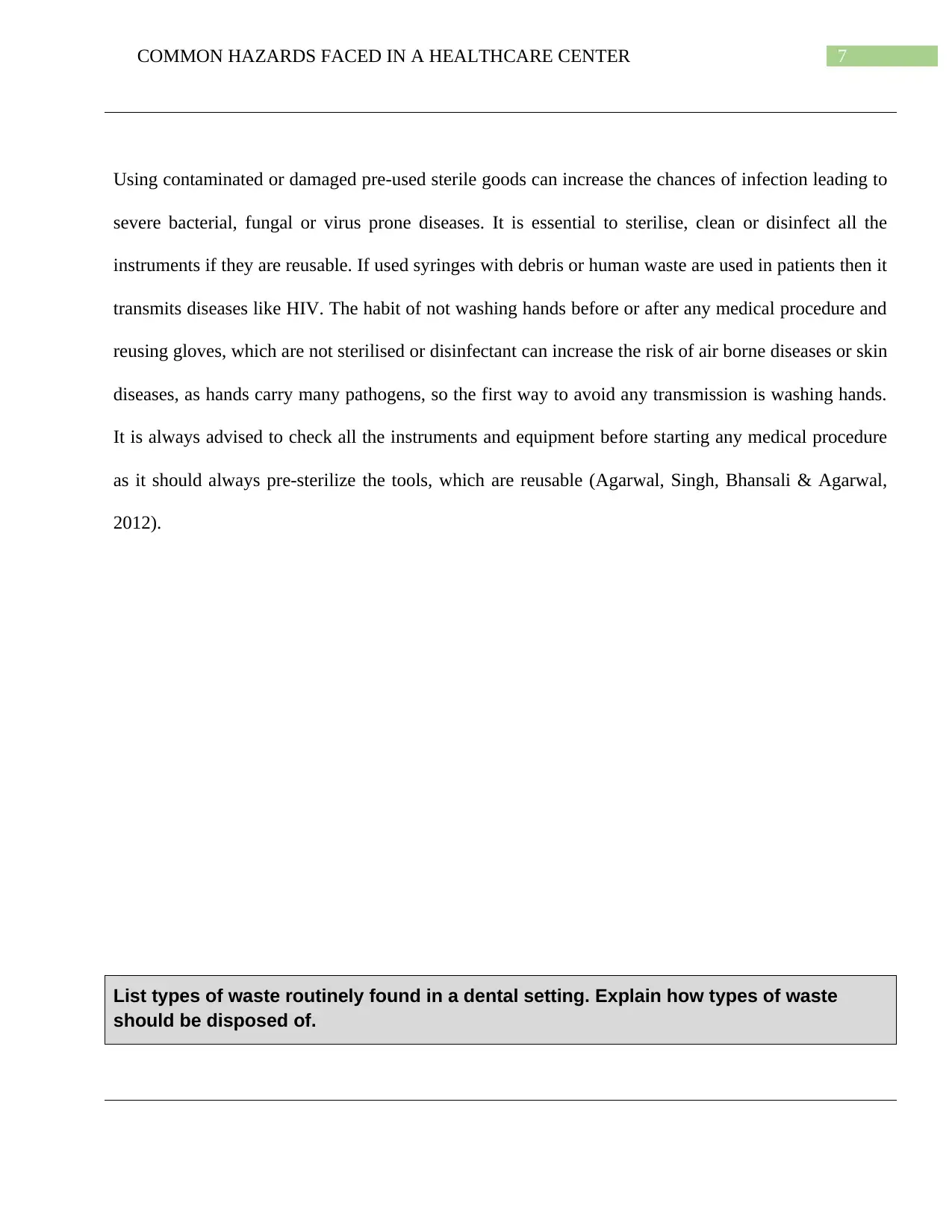
7COMMON HAZARDS FACED IN A HEALTHCARE CENTER
Using contaminated or damaged pre-used sterile goods can increase the chances of infection leading to
severe bacterial, fungal or virus prone diseases. It is essential to sterilise, clean or disinfect all the
instruments if they are reusable. If used syringes with debris or human waste are used in patients then it
transmits diseases like HIV. The habit of not washing hands before or after any medical procedure and
reusing gloves, which are not sterilised or disinfectant can increase the risk of air borne diseases or skin
diseases, as hands carry many pathogens, so the first way to avoid any transmission is washing hands.
It is always advised to check all the instruments and equipment before starting any medical procedure
as it should always pre-sterilize the tools, which are reusable (Agarwal, Singh, Bhansali & Agarwal,
2012).
List types of waste routinely found in a dental setting. Explain how types of waste
should be disposed of.
Using contaminated or damaged pre-used sterile goods can increase the chances of infection leading to
severe bacterial, fungal or virus prone diseases. It is essential to sterilise, clean or disinfect all the
instruments if they are reusable. If used syringes with debris or human waste are used in patients then it
transmits diseases like HIV. The habit of not washing hands before or after any medical procedure and
reusing gloves, which are not sterilised or disinfectant can increase the risk of air borne diseases or skin
diseases, as hands carry many pathogens, so the first way to avoid any transmission is washing hands.
It is always advised to check all the instruments and equipment before starting any medical procedure
as it should always pre-sterilize the tools, which are reusable (Agarwal, Singh, Bhansali & Agarwal,
2012).
List types of waste routinely found in a dental setting. Explain how types of waste
should be disposed of.
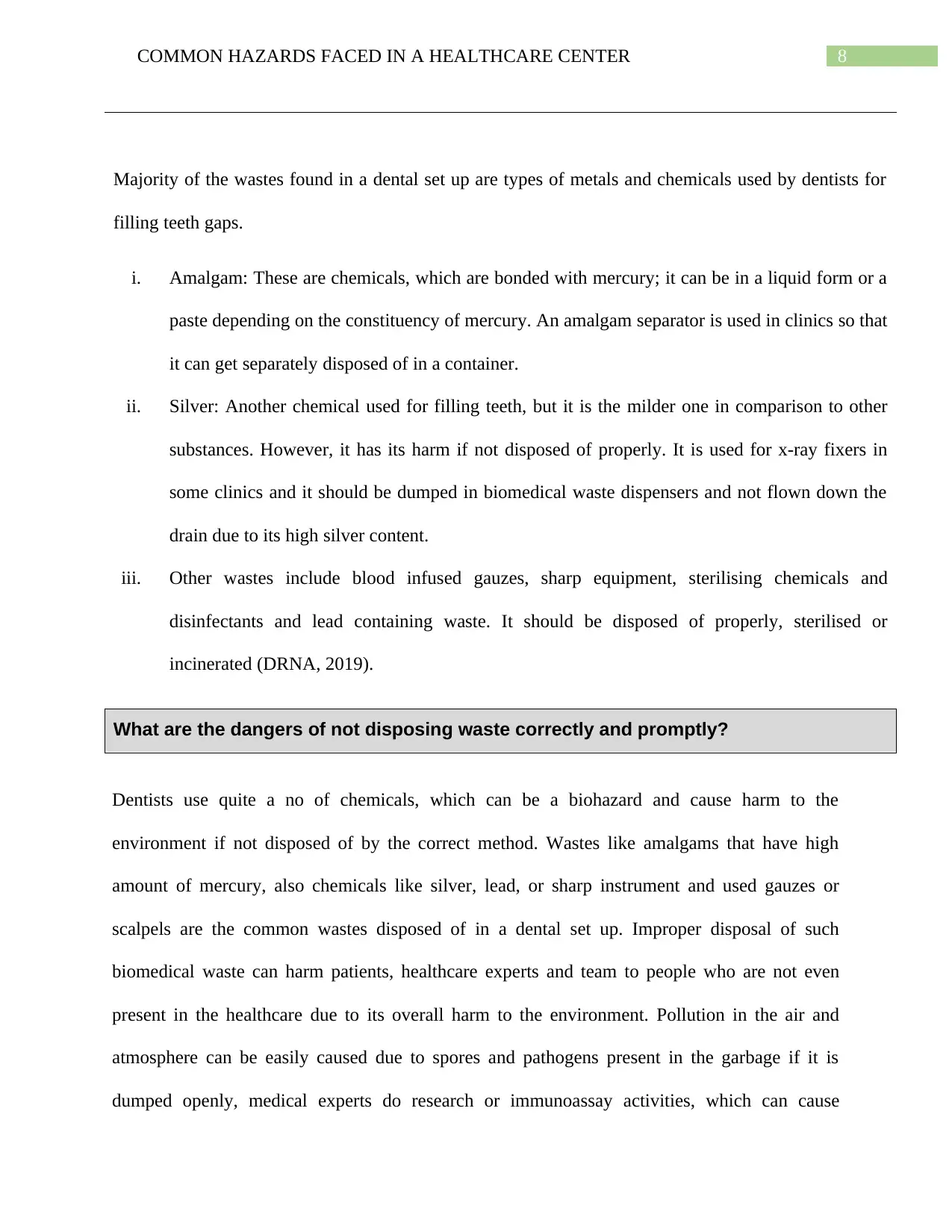
8COMMON HAZARDS FACED IN A HEALTHCARE CENTER
Majority of the wastes found in a dental set up are types of metals and chemicals used by dentists for
filling teeth gaps.
i. Amalgam: These are chemicals, which are bonded with mercury; it can be in a liquid form or a
paste depending on the constituency of mercury. An amalgam separator is used in clinics so that
it can get separately disposed of in a container.
ii. Silver: Another chemical used for filling teeth, but it is the milder one in comparison to other
substances. However, it has its harm if not disposed of properly. It is used for x-ray fixers in
some clinics and it should be dumped in biomedical waste dispensers and not flown down the
drain due to its high silver content.
iii. Other wastes include blood infused gauzes, sharp equipment, sterilising chemicals and
disinfectants and lead containing waste. It should be disposed of properly, sterilised or
incinerated (DRNA, 2019).
What are the dangers of not disposing waste correctly and promptly?
Dentists use quite a no of chemicals, which can be a biohazard and cause harm to the
environment if not disposed of by the correct method. Wastes like amalgams that have high
amount of mercury, also chemicals like silver, lead, or sharp instrument and used gauzes or
scalpels are the common wastes disposed of in a dental set up. Improper disposal of such
biomedical waste can harm patients, healthcare experts and team to people who are not even
present in the healthcare due to its overall harm to the environment. Pollution in the air and
atmosphere can be easily caused due to spores and pathogens present in the garbage if it is
dumped openly, medical experts do research or immunoassay activities, which can cause
Majority of the wastes found in a dental set up are types of metals and chemicals used by dentists for
filling teeth gaps.
i. Amalgam: These are chemicals, which are bonded with mercury; it can be in a liquid form or a
paste depending on the constituency of mercury. An amalgam separator is used in clinics so that
it can get separately disposed of in a container.
ii. Silver: Another chemical used for filling teeth, but it is the milder one in comparison to other
substances. However, it has its harm if not disposed of properly. It is used for x-ray fixers in
some clinics and it should be dumped in biomedical waste dispensers and not flown down the
drain due to its high silver content.
iii. Other wastes include blood infused gauzes, sharp equipment, sterilising chemicals and
disinfectants and lead containing waste. It should be disposed of properly, sterilised or
incinerated (DRNA, 2019).
What are the dangers of not disposing waste correctly and promptly?
Dentists use quite a no of chemicals, which can be a biohazard and cause harm to the
environment if not disposed of by the correct method. Wastes like amalgams that have high
amount of mercury, also chemicals like silver, lead, or sharp instrument and used gauzes or
scalpels are the common wastes disposed of in a dental set up. Improper disposal of such
biomedical waste can harm patients, healthcare experts and team to people who are not even
present in the healthcare due to its overall harm to the environment. Pollution in the air and
atmosphere can be easily caused due to spores and pathogens present in the garbage if it is
dumped openly, medical experts do research or immunoassay activities, which can cause
⊘ This is a preview!⊘
Do you want full access?
Subscribe today to unlock all pages.

Trusted by 1+ million students worldwide

9COMMON HAZARDS FACED IN A HEALTHCARE CENTER
emission of radioactive gases that can destruct the atmosphere (Janagi, Shah & Maheshwari,
2015).
emission of radioactive gases that can destruct the atmosphere (Janagi, Shah & Maheshwari,
2015).
Paraphrase This Document
Need a fresh take? Get an instant paraphrase of this document with our AI Paraphraser

10COMMON HAZARDS FACED IN A HEALTHCARE CENTER
References
Agarwal, B., Singh, S., Bhansali, S., & Agarwal, S. (2012). Waste management in dental office.
Indian Journal Of Community Medicine, 37(3), 201.
Aravind, B. S., Joy, E. T., Kiran, M. S., Sherubin, J. E., Sajesh, S., & Manchil, P. R. D. (2016).
Attitude and awareness of general dental practitioners toward radiation hazards and
safety. Journal of pharmacy & bioallied sciences, 8(Suppl 1), S53.
DRNA. (2019). Understanding Waste Management: 6 Common Types of Dental Waste and How
to Handle Them | Dental Recycling of North America. Retrieved 1 October 2019, from
http://www.drna.com/blog/54/understanding-waste-management-6-common-types-of-
dental-waste-and-how-to-handle-them.php
Janagi, R., Shah, J., &Maheshwari, D. (2015). Scenario of Management of Medical Waste in US
and UK: a review. Journal of Global Trends in Pharmaceutical Sciences, 6(1), 2328-
2339.
Ndejjo, R., Musinguzi, G., Yu, X., Buregyeya, E., Musoke, D., Wang, J. S., ... & Ssempebwa, J.
(2015). Occupational health hazards among healthcare workers in Kampala,
Uganda. Journal of environmental and public health, 2015.
nhs.uk. (2019). What infections can used needles or sharps pass on?. Retrieved 2 October 2019,
from https://www.nhs.uk/common-health-questions/infections/what-infections-can-used-
needles-or-sharps-pass-on/
References
Agarwal, B., Singh, S., Bhansali, S., & Agarwal, S. (2012). Waste management in dental office.
Indian Journal Of Community Medicine, 37(3), 201.
Aravind, B. S., Joy, E. T., Kiran, M. S., Sherubin, J. E., Sajesh, S., & Manchil, P. R. D. (2016).
Attitude and awareness of general dental practitioners toward radiation hazards and
safety. Journal of pharmacy & bioallied sciences, 8(Suppl 1), S53.
DRNA. (2019). Understanding Waste Management: 6 Common Types of Dental Waste and How
to Handle Them | Dental Recycling of North America. Retrieved 1 October 2019, from
http://www.drna.com/blog/54/understanding-waste-management-6-common-types-of-
dental-waste-and-how-to-handle-them.php
Janagi, R., Shah, J., &Maheshwari, D. (2015). Scenario of Management of Medical Waste in US
and UK: a review. Journal of Global Trends in Pharmaceutical Sciences, 6(1), 2328-
2339.
Ndejjo, R., Musinguzi, G., Yu, X., Buregyeya, E., Musoke, D., Wang, J. S., ... & Ssempebwa, J.
(2015). Occupational health hazards among healthcare workers in Kampala,
Uganda. Journal of environmental and public health, 2015.
nhs.uk. (2019). What infections can used needles or sharps pass on?. Retrieved 2 October 2019,
from https://www.nhs.uk/common-health-questions/infections/what-infections-can-used-
needles-or-sharps-pass-on/
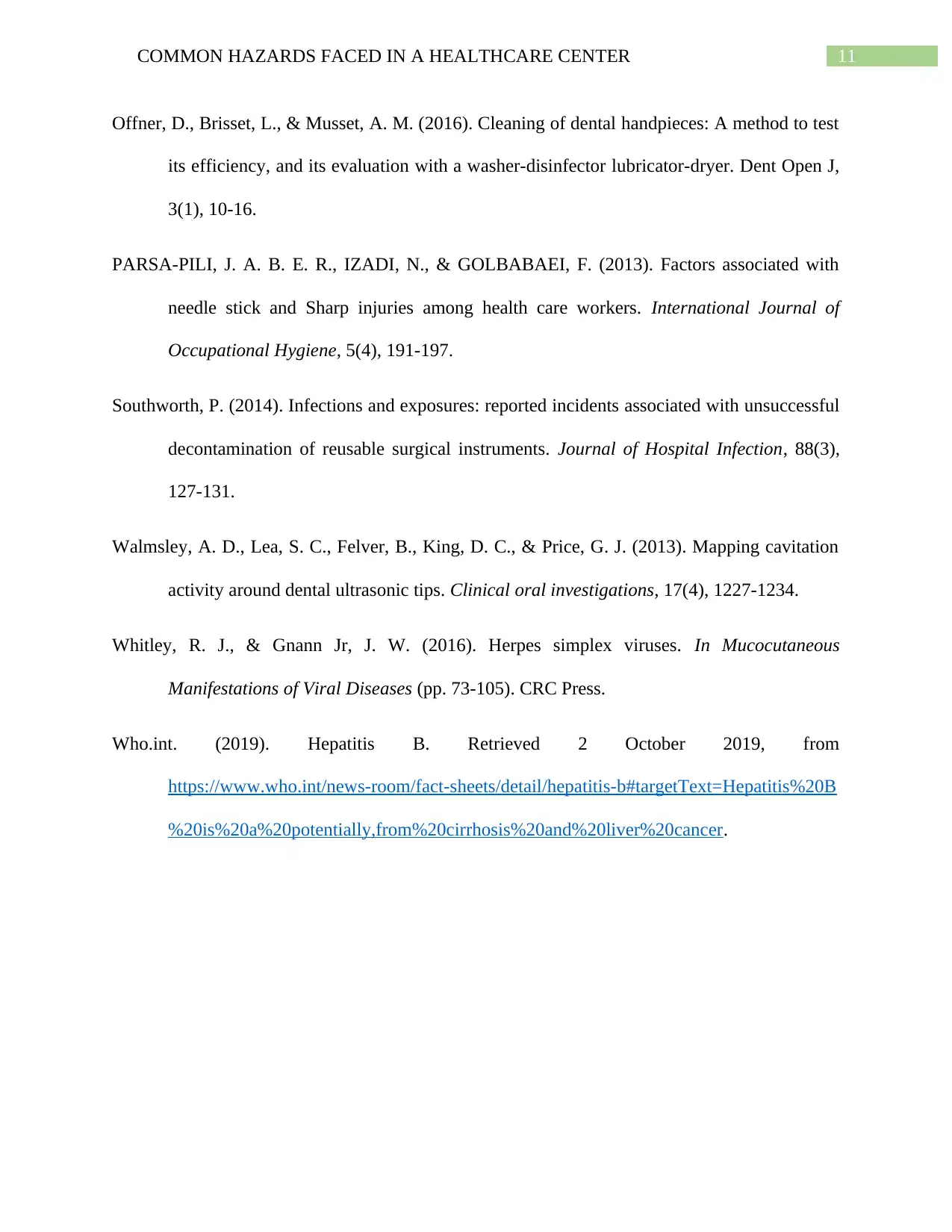
11COMMON HAZARDS FACED IN A HEALTHCARE CENTER
Offner, D., Brisset, L., & Musset, A. M. (2016). Cleaning of dental handpieces: A method to test
its efficiency, and its evaluation with a washer-disinfector lubricator-dryer. Dent Open J,
3(1), 10-16.
PARSA-PILI, J. A. B. E. R., IZADI, N., & GOLBABAEI, F. (2013). Factors associated with
needle stick and Sharp injuries among health care workers. International Journal of
Occupational Hygiene, 5(4), 191-197.
Southworth, P. (2014). Infections and exposures: reported incidents associated with unsuccessful
decontamination of reusable surgical instruments. Journal of Hospital Infection, 88(3),
127-131.
Walmsley, A. D., Lea, S. C., Felver, B., King, D. C., & Price, G. J. (2013). Mapping cavitation
activity around dental ultrasonic tips. Clinical oral investigations, 17(4), 1227-1234.
Whitley, R. J., & Gnann Jr, J. W. (2016). Herpes simplex viruses. In Mucocutaneous
Manifestations of Viral Diseases (pp. 73-105). CRC Press.
Who.int. (2019). Hepatitis B. Retrieved 2 October 2019, from
https://www.who.int/news-room/fact-sheets/detail/hepatitis-b#targetText=Hepatitis%20B
%20is%20a%20potentially,from%20cirrhosis%20and%20liver%20cancer.
Offner, D., Brisset, L., & Musset, A. M. (2016). Cleaning of dental handpieces: A method to test
its efficiency, and its evaluation with a washer-disinfector lubricator-dryer. Dent Open J,
3(1), 10-16.
PARSA-PILI, J. A. B. E. R., IZADI, N., & GOLBABAEI, F. (2013). Factors associated with
needle stick and Sharp injuries among health care workers. International Journal of
Occupational Hygiene, 5(4), 191-197.
Southworth, P. (2014). Infections and exposures: reported incidents associated with unsuccessful
decontamination of reusable surgical instruments. Journal of Hospital Infection, 88(3),
127-131.
Walmsley, A. D., Lea, S. C., Felver, B., King, D. C., & Price, G. J. (2013). Mapping cavitation
activity around dental ultrasonic tips. Clinical oral investigations, 17(4), 1227-1234.
Whitley, R. J., & Gnann Jr, J. W. (2016). Herpes simplex viruses. In Mucocutaneous
Manifestations of Viral Diseases (pp. 73-105). CRC Press.
Who.int. (2019). Hepatitis B. Retrieved 2 October 2019, from
https://www.who.int/news-room/fact-sheets/detail/hepatitis-b#targetText=Hepatitis%20B
%20is%20a%20potentially,from%20cirrhosis%20and%20liver%20cancer.
⊘ This is a preview!⊘
Do you want full access?
Subscribe today to unlock all pages.

Trusted by 1+ million students worldwide
1 out of 12
Related Documents
Your All-in-One AI-Powered Toolkit for Academic Success.
+13062052269
info@desklib.com
Available 24*7 on WhatsApp / Email
![[object Object]](/_next/static/media/star-bottom.7253800d.svg)
Unlock your academic potential
Copyright © 2020–2025 A2Z Services. All Rights Reserved. Developed and managed by ZUCOL.





